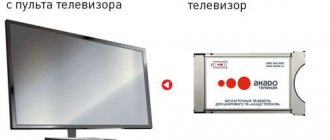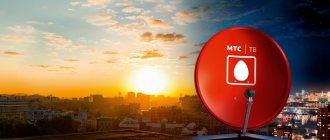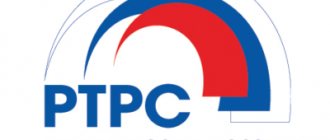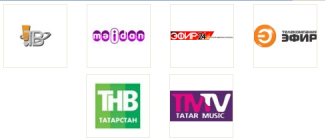Owners of old TVs will have to pay to broadcast in the new format.
From January 1, 2021, digital television in the Russian Federation will replace analogue; this decision was actually made by the Government of the Russian Federation 10 years ago. All this time, the necessary infrastructure was being prepared under the control of officials. Already in 2021, television broadcasting will be organized according to a new principle, however, the exact timing of the complete abandonment of analogue TV is not yet clear.
We’ll tell you in more detail how digital TV differs from analogue, how the transition to digital television will happen in Russia in 2019, what ordinary citizens should do, and how not to fall for the tricks of scammers.
What is digital TV and how does it differ from analogue?
Terms such as cable channel package and digital TV have become firmly established in everyday life, but not everyone knows what they mean. There are three types of television broadcasting:
- ethereal,
- cable,
- satellite.
Let's look at their features in the table.
| Essential | Cable | Satellite | |
| Signal transmission method | Broadcasting is carried out using television towers | The signal is transmitted through the cable | The broadcast is carried out by satellites distributed over the equator |
| Signal transmission equipment | Antenna or repeater for receiving a signal | Cable carried out by specialists from cable operator organizations | Satellite dishes "dishes" in common parlance |
Terrestrial and cable TV can be either analogue or digital. The difference lies in the method of signal transmission. Analog is continuous, but it is vulnerable to interference and cannot provide the required picture quality, which is why it is currently considered obsolete. Digital television allows you to transmit more channels in better quality due to the fact that digital encoding and data compression occur. In addition, it provides many more opportunities.
List of free channels
The digital broadcasting package is distributed among multiplexes, each with 10 channels. 20 of them are broadcast normally, the third package is being tested.
You can find and configure them manually or automatically.
With cable television, the list will contain the list provided by the operator.
First multiplex
On the territory of the Russian Federation, by Decree of the President of the Russian Federation No. 715 “On all-Russian mandatory public television channels and radio channels” dated June 24, 2009, the First Multiplex was approved. This is a list of free television and radio channels, which includes news, development and information programs.
They are transmitted at the same frequency, so they are all connected together. They work wherever there is digital television.
The package contains the following channels:
- federal: First, Russia 1, NTV, St. Petersburg channel 5, Russia K, TV Center;
- sports – Match TV;
- news – Russia 24;
- children's - Carousel;
- Public television of Russia - OTR.
In addition, there are 3 radio stations: Mayak, Radio Russia and Vesti FM. All programs are broadcast in MPEG4 video, MPEG2 audio at a frequency of 546 MHz, TVK - 30.
- Psoriasis - treatment and reviews
- Indications for use of panangin
- How to gain followers on Instagram for free and quickly
Second multiplex
The entertainment broadcast package may not yet be available in all regions of Russia.
It requires another repeater (RTRS-2), which must be far from RTRS-1. To select the channels that will be included in the package, a competition for broadcasting rights is held annually. The multiplex is caught at a frequency of 498 MHz, corresponding to channel 24.
The package includes programs:
- entertainment - STS, Domashny, TV3 and Pyatnitsa;
- federal – REN TV;
- religion – SPAS;
- military-patriotic - Star;
- CIS - WORLD;
- films - TNT;
- music – Muz TV.
Test multiplex
The third set, unlike other packages, contains more entertainment, sports, information and educational channels.
The service has not yet been officially launched and is in test mode from the Ostankino TV tower; the signal is received within a radius of 100 km.
The broadcast is broadcast at a frequency of 578 MHz, TVK 34:
- Sports 1;
- Sports 2;
- Fight club;
- My planet;
- Science 2.0;
- Russian novel;
- Russian bestseller;
- Russian detective;
- Story;
- Cartoon;
- Sundress;
- A country;
- Living Planet;
- IQ HD (SD quality);
- 24 Doc;
- Techno 24;
- Mother;
- NST;
- Amusement park;
- Moscow. Confidence;
- euronews;
- Music of the First;
- Home Cinema;
- Time;
- TV cafe;
- Beaver;
- 365 days of TV;
- TNT-Comedy;
- Lots of TV;
- HD Life (SD quality);
- STV;
- India TV;
- Fighter;
- Comedy TV;
- La Minor;
- Men's cinema;
- Kitchen TV;
- Auto Plus;
- LifeNews;
- Our football.
Latest news: when will the transition take place?
The timing of switching off analogue television in Russia has not actually been established at all. The fact is that there are no plans to turn off analogue television. As Andrei Romanchenko, General Director of the Russian Television and Radio Network, says, we are only talking about reducing analogue broadcasting due to the fact that the state is stopping subsidizing it. That is, in fact, this only applies to public channels. All other channels (TNS, REN TV, STS, etc., as well as all regional channels) will not be limited in any way in their ability to use analogue broadcasting.
In the Government of the Russian Federation itself, along with the term “switching to digital TV,” they use the phrase “switching off analogue TV.” According to the official, analogue terrestrial television broadcasting in Russian cities with a population of up to 100 thousand people will gradually (and not simultaneously, as previously assumed) be turned off.
The transition to digital broadcasting was planned in the federal target program “Development of Television and Radio Broadcasting for 2009-2018”.
Thus, from January 1 of next year it should have already been implemented. Significant funds from the federal budget were allocated for preparatory activities. The construction of the first and second multiplex network has been completed in most regions of the Russian Federation. However, at a meeting held on November 15, 2021, the government decided to extend the implementation of the transition. The fact is that, according to experts, from 15 to 30% of all televisions in the country can only receive an analog signal. Work needs to be done with the population, the government decided and entrusted this to local authorities. It was decided to make the final transition to “digital” in stages, and it will take six months.
Prime Minister Dmitry Medvedev indicated that it is necessary to specifically determine the stages of the transition, the regions where “digital” will be launched in full and in test mode. It is likely that administrative and regulatory acts will be adopted in the near future.
Digital television from January 1, 2021 – what do you need to know?
Owners of old TVs will have to pay to broadcast in the new format.
From January 1, 2021, digital television in the Russian Federation will replace analogue television - this decision was actually made by the Government of the Russian Federation 10 years ago. All this time, the necessary infrastructure was being prepared under the control of officials. Already in 2021, television broadcasting will be organized according to a new principle, however, the exact timing of the complete abandonment of analogue TV is not yet clear.
We’ll tell you in more detail how digital TV differs from analogue, how the transition to digital television will happen in Russia in 2019, what ordinary citizens should do, and how not to fall for the tricks of scammers.
What is digital TV and how does it differ from analogue?
Terms such as cable channel package and digital TV have become firmly established in everyday life, but not everyone knows what they mean. There are three types of television broadcasting:
- ethereal
- cable
- satellite
Let's look at their features in the table.
Terrestrial and cable TV can be either analogue or digital. The difference lies in the method of signal transmission. Analog is continuous, but it is vulnerable to interference and cannot provide the required picture quality, which is why it is currently considered obsolete. Digital television allows you to transmit more channels in better quality due to the fact that digital encoding and data compression occur. In addition, it provides many more opportunities.
Latest news: when will the transition take place?
The timing of switching off analogue television in Russia has not actually been established at all. The fact is that there are no plans to turn off analogue television. As Andrei Romanchenko, General Director of the Russian Television and Radio Network, says, we are only talking about reducing analogue broadcasting due to the fact that the state is stopping subsidizing it. That is, in fact, this only applies to public channels. All other channels (TNS, REN TV, STS, etc., as well as all regional channels) will not be limited in any way in their ability to use analogue broadcasting.
In the Government of the Russian Federation itself, along with the term “switching to digital TV,” they use the phrase “switching off analogue TV.” According to the official, analogue terrestrial television broadcasting in Russian cities with a population of up to 100 thousand people will gradually (and not simultaneously, as previously assumed) be turned off.
The transition to digital broadcasting was planned in the federal target program “Development of Television and Radio Broadcasting for 2009-2018”. Thus, from January 1 of next year it should have already been implemented. Significant funds from the federal budget were allocated for preparatory activities. The construction of the first and second multiplex network has been completed in most regions of the Russian Federation. However, at a meeting held on November 15, 2021, the government decided to extend the implementation of the transition. The fact is that, according to experts, from 15 to 30% of all televisions in the country can only receive an analog signal. Work needs to be done with the population, the government decided and entrusted this to local authorities.
It was decided to make the final transition to “digital” in stages, and it will take six months. Prime Minister Dmitry Medvedev indicated that it is necessary to specifically determine the stages of the transition, the regions where “digital” will be launched in full and in test mode. It is likely that administrative and regulatory acts will be adopted in the near future.
What equipment will be needed and how much does it cost?
What do you need to connect to digital TV in 2021? Government experts say most modern TVs can receive digital signals without additional equipment. Almost all TVs purchased after 2013 have this feature.
Older models will require the purchase of a special attachment. Such a device is called a “DVB-T2/T digital terrestrial channel receiver”. Again, government experts provide official figures: the cost of such receivers (set-top boxes): 1000-2000 rubles. Experts say that you can’t buy a high-quality gadget for this money; you’ll have to pay 5-10 times more. The Federal Antimonopoly Service will ensure that during the mass transition to digital, retailers do not artificially inflate prices for necessary equipment.
The transition to digital television from January 1, 2021 in an apartment building (MKD) may be complicated by the need to connect to a collective antenna, without which the receiver does not work, and in many houses they have already been dismantled. You will need to either restore or purchase an indoor antenna. In Moscow, for example, the on-air signal has long been transmitted through regional repeaters. To restore the collective antenna, you must contact the management company or the HOA.
Beware: scammers
The transition to digital TV from January 1, 2021 is, of course, good news. Russians will receive a completely free set of television and radio channels of excellent quality. Thus, a broadcasting network is being created in Russia, including two multiplexes and three radio channels. Population coverage is more than 98%. Each multiplex includes 10 channels.
However, fraudulent schemes have already been invented to deceive citizens. Until now, explanatory work on the ground has not been carried out actively enough. Therefore, not all Russians have an idea about the necessary equipment: how much it costs, and whether it is necessary to install it. There are already known cases when expensive set-top boxes for digital TV were sold to pensioners in Moscow and St. Petersburg, although many buyers’ TVs are capable of receiving such broadcasts without additional equipment.
What equipment will be needed and how much does it cost?
What do you need to connect to digital TV in 2021? Government experts say most modern TVs can receive digital signals without additional equipment. Almost all TVs purchased after 2013 have this feature.
Older models will require the purchase of a special attachment. Such a device is called a “DVB-T2/T digital terrestrial channel receiver”. Again, government experts provide official figures: the cost of such receivers (set-top boxes): 1000-2000 rubles. Experts say that you can’t buy a high-quality gadget for this money; you’ll have to pay 5-10 times more. The Federal Antimonopoly Service will ensure that during the mass transition to digital, retailers do not artificially inflate prices for necessary equipment.
The transition to digital television from January 1, 2021 in an apartment building (MKD) may be complicated by the need to connect to a collective antenna, without which the receiver does not work, and in many houses they have already been dismantled. You will need to either restore or purchase an indoor antenna. In Moscow, for example, the on-air signal has long been transmitted through regional repeaters. To restore the collective antenna, you must contact the management company or the HOA.
Reasons and benefits of switching
The refusal to use analog TV is due to several reasons. Firstly, digital has a number of advantages:
- Provides high resolution (HD) and better picture and sound quality. There is no interference, ripples or other problems with the signal, as it does not depend on weather conditions. The difference between digital and analog TV is noticeable to the naked eye. Now people will be able to watch programs in the same quality as the operators in the recording studio, regardless of where they live.
- Provides access to a larger number of channels (with the old technology you can only watch 2-4 programs).
- Unlike cable and satellite TV, you do not need to pay for the basic package of digital TV channels.
Secondly, almost no one uses analog devices anymore. At the end of 2021, it was estimated that 90% of the country's population is connected to digital terrestrial television, and in some regions this figure reaches 99%. Those units that are still connected to analog (mostly residents of the suburbs) complain about a poor signal and picture. The few channels that can be tuned often disappear; Even powerful antennas cannot save you. And this situation has been observed for quite some time. Why didn't we make the transition to digital earlier? There are reasons for this.
Interesting to know: European countries began to gradually abandon analogue television broadcasting back in 2006. Our neighbors - Azerbaijan, Poland, Uzbekistan, Armenia, also no longer use this outdated technology.
Beware: scammers
The transition to digital TV from January 1, 2021 is, of course, good news. Russians will receive a completely free set of television and radio channels of excellent quality. Thus, a broadcasting network is being created in Russia, including two multiplexes and three radio channels. Population coverage is more than 98%. Each multiplex includes 10 channels.
| 1 multiplex | 2 multiplex |
| All-Russian mandatory public channels | All-Russian mandatory channels |
| First | Saved |
| Russia 1 | STS |
| Russia 24 | TV-3 |
| Fifth | Star |
| Match TV | TNT |
| TV Center | Muz TV |
| OTR | World |
| NTV | Friday! |
| Russia-Culture | Home |
| Carousel | REN TV |
However, fraudulent schemes have already been invented to deceive citizens. Until now, explanatory work on the ground has not been carried out actively enough. Therefore, not all Russians have an idea about the necessary equipment: how much it costs, and whether it is necessary to install it. There are already known cases when expensive set-top boxes for digital TV were sold to pensioners in Moscow and St. Petersburg, although many buyers’ TVs are capable of receiving such broadcasts without additional equipment.
According to readers, receipts for payment for the transition to digital TV are being sent to mailboxes in Nizhny Novgorod with links to non-existent legal acts and details of scammers. Despite the fact that the transition to digital TV does not involve the payment of state duties, taxes or other fees to the state treasury, many pay for receipts from scammers, believing that this is just another type of housing and communal services. This is wrong. Take care of your money.
How to receive a DVB-T2 signal?
Above we indicated the dates when analogue television broadcasting is turned off in different regions. But don't confuse them with when the digital signal starts broadcasting. It can be caught for several years now. In the largest populated areas there are two multiplexes - this is the name of the packages, which in the case of our country consist of ten TV channels. The broadcasting is completely free - even satellite operators do not require money to view these packages.
To receive a digital signal, you will need either an appropriate TV or a digital set-top box. Absolutely all LCD TVs currently on TV shelves have DVB-T2 support. But if you bought an LCD TV at least five years ago, then it is possible that it only understands the DVB-T standard, and it has not been used in our country for a long time. There are several ways to determine whether your TV supports DVB-T2:
- After reading the operating instructions, which will necessarily indicate all the digital TV standards that the TV can understand;
- Paying attention to the box - if DVB-T2 is supported, then the logo of this standard will definitely be placed on it;
- By reading the technical specifications of your TV contained on the manufacturer's official website.
Channel tuning occurs as usual. If along the way you are asked what type of television signal you are looking for, then feel free to select the “Digital TV” option.
You only need to buy a digital television set-top box for old TVs.
If the TV does not support the DVB-T2 standard, then it will soon stop showing TV channels. It is for owners of such devices that digital set-top boxes are produced. Absolutely all of them can recognize a DVB-T2 signal. But don't confuse a digital set-top box with a smart set-top box. The latter is intended exclusively for accessing the Internet - it often does not have an antenna connector.
To control the digital TV set-top box, the included remote control is used. This is a serious drawback - you have to first turn on the TV with your remote, and then use a second accessory to change channels. However, if this bothers you, then you can get a universal remote control that supports up to four or even more devices! But don’t be surprised that such a remote control will cost more than a TV set-top box.
Read “How to choose a digital set-top box for your TV”
In any case, after purchase, it is recommended to check the digital set-top box to see how hot it gets. If the case does not heat up significantly, then such a device will most likely last more than two to three years.
Where is digital TV broadcast?
The Russian government has stated that 95% of our country’s residents now have access to a digital television signal (9.5 thousand transmitters have been installed and activated).
Unfortunately, with such a huge area it is impossible to provide 100% coverage. There will always be very remote villages, in which only a few dozen people live - installing repeaters near them is too expensive. Alas, such people have only one thing left: to connect satellite television.
If we're talking about satellite TV operators, they usually don't ask for money for watching twenty federal TV channels. That is, you can watch them without a subscription fee. You will only need money if you suddenly want to watch some other channels that are not included in the list of two public multiplexes.
But we must admit that buying a satellite dish and receiver is an expensive pleasure. But you still need to install an antenna! By the way, at first the government promises to compensate at least part of the salaries - this applies to low-income families and residents of the very villages that the DVB-T2 over-the-air signal cannot reach.
Is it possible to find out a digital TV coverage map?
Do not miss:
- Digital television DVB in Russia. All formats, coverage, pros, cons and...
- How to choose a projector for your home to connect to a computer, smartphone,…
- Which TV is best to buy in 2021?
Yes, you can easily watch it on a special website. On this map you will also see icons in the form of television towers. If you click on this icon located near your place of residence, you can see how many TV channel packages it broadcasts and on what frequencies it does so. This may be useful for setting up your TV.
Please note that 95% of residents of our country have access to one multiplex (10 TV channels). You can catch 20 channels only in large cities with a population exceeding 20 thousand inhabitants. However, this bar is gradually being lowered. It is possible that in the near future the second multiplex will be broadcast in urban settlements.











